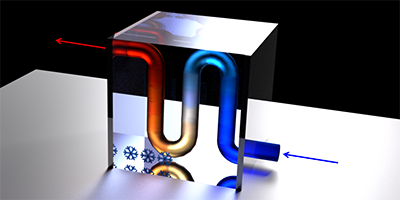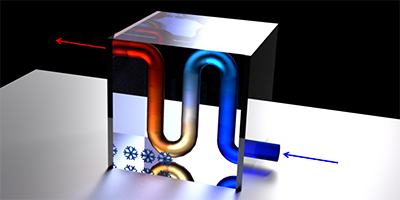A Polariton Fridge for Semiconductors
In laser cooling schemes, photons take energy and momentum from atoms and molecules, bringing them to near-zero temperatures. Similar methods could cool semiconductor devices without the need for noisy cryostats or cryogenic liquids. But cooling a solid using lasers remains challenging: light absorbed by the material is rapidly converted into lattice vibrations (phonons), heating up the solid. Now, Maxime Richard at the Institut Néel of the University of Grenoble and CNRS, France, and colleagues have demonstrated a new cooling technique that uses a gas of so-called “exciton polaritons” to cool a semiconductor material.
In a semiconductor, exciton polaritons are hybrid states formed through the coupling of photons with excitons (bound electron-hole pairs). Being partly photons and partly excitons, they can interact with both light and phonons, allowing efficient energy exchange between the two. In the authors’ scheme, blue laser light generates “cold” polaritons in a -micrometer-sized spot within a semiconductor cavity designed to optimize the polariton-phonon coupling. Each generated polariton can then absorb a phonon, generating a higher-energy “hot” polariton. Finally, the hot polariton recombines radiatively, emitting a photon that leaves the cavity. The net effect is a cooling of the cavity through the loss of vibrational energy.
Since the cavity is only excited locally by the laser and is not thermally isolated, the authors could not measure a macroscopic temperature drop for the whole system. But by probing the crystal’s vibrations, they could determine the cooling power generated by their scheme. The results suggest that such a “polariton fridge” could efficiently cool nanoscale semiconductor devices.
This research is published in Physical Review Letters.
–Matteo Rini





